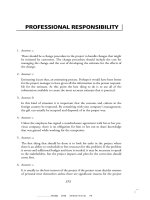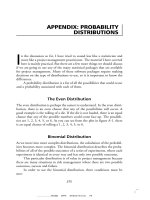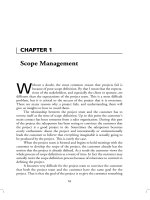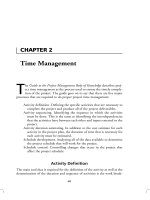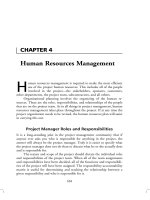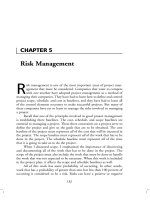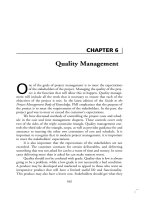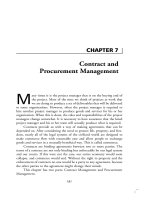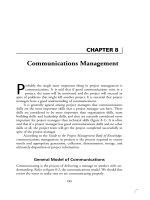Management Presentation Chapter 2
Bạn đang xem bản rút gọn của tài liệu. Xem và tải ngay bản đầy đủ của tài liệu tại đây (933.65 KB, 31 trang )
The Organization’s Environments
• External Environment: Everything that is outside an organization.
– General environment is a set of broad dimensions and forces in an organization’s
surroundings that determine its overall context
– Task environment is composed of specific groups and organizations that affect the firm.
• Internal Environment: Conditions and forces within an organization.
© 2014 Cengage Learning. All rights reserved. May not be copied, scanned, or duplicated, in whole or in part, except for use as permitted in a license distributed with a certain product or service or otherwise on a passwordprotected website for classroom use.
2–2
The Organization and Its Environments
The general environment consists of broad dimensions and forces in
Technological
an organization's context
dimension
The task environment is the specific organizations or groups that have
a direct impact on a firm
Competitors
The internal environment consists of conditions and forces within the
organization.
Owners
Regulators
Customers
Employees
Physical environment
Board of directors
Culture
Political-
Economic
legal
dimension
Strategic
dimension
Suppliers
partners
Internal environment
Task environment
General environment
External
environment
© 2014 Cengage Learning. All rights reserved. May not be copied, scanned, or duplicated, in whole or in part, except for use as permitted in a license distributed with a certain product or service or otherwise on a passwordprotected website for classroom use.
2–3
The External Environment
• The General Environment
– Economic dimension: Overall health of the economic system in which the organization
operates.
– Technological dimension: Methods available for converting resources into products or
services.
– Political-legal dimension: Government regulation of business and the relationship between
business and government.
2–4
The External Environment (cont’d)
• Dimensions of the Task
Environment
– Specific groups affecting the organization
•
Competitors: The other organizations that compete for the same resources.
•
Customers: Pay money to acquire an organization’s products or services.
•
Suppliers: Provide resources for other organizations.
2–5
The External Environment (cont’d)
• Dimensions of the Task
–
Environment
Regulators: Have the potential to control, regulate or influence an organization's policies and
practices.
•
Regulatory agencies are created by the government to protect the public from certain
business practices or to protect organizations from one another.
•
Interest groups: are groups organized by members to attempt to influence organizations.
– Specific groups affecting the organization
•
Strategic partners (also called strategic allies): Two or more companies work together in joint
ventures.
2–6
FIGURE 2.1
McDonald’s Task Environment
© 2014 Cengage Learning. All rights reserved. May not be copied, scanned, or duplicated, in whole or in part, except for use as permitted in a license distributed with a certain product or service or otherwise on a password-protected
website for classroom use.
2–7
The Internal Environment
• Conditions and forces within an organization
– Owners with legal property rights to a business.
– Board of directors who oversee management of the firm to best serve stockholders’ interest.
– Employees who work for the firm and have a vested interest in its continued operation and
existence.
– Physical work environment of the organization and the work that people do.
2–8
Individual Ethics In Organizations
• Ethics
– An individual’s personal beliefs regarding what is right or wrong or good or bad.
• Ethical Behavior
– Behavior that is acceptable in the eye of the beholder.
– Behavior that conforms to accepted social norms.
• Examples of Unethical Behavior
– “Borrowing” office supplies for personal use.
– Spending most of the work time browsing Facebook and personal websites.
Question: Does an organization have ethics?
2–9
Determinants of Individual Ethics
Family
Situational
Values and
Influences
Factors
Morals
Experiences
Peer
Influences
Individual Ethics
© 2014 Cengage Learning. All rights reserved. May not be copied, scanned, or duplicated, in whole or in part, except for use as permitted in a license distributed with a certain product or service or otherwise on a passwordprotected website for classroom use.
2–10
Fostering Ethical Organization Behavior
Managing Ethical Behavior
Top Management Involvement
Train
Written Code
Employees
of Ethics
Individual Issues:
Behavior, Conscience, Privacy
© 2014 Cengage Learning. All rights reserved. May not be copied, scanned, or duplicated, in whole or in part, except for use as permitted in a license distributed with a certain product or service or otherwise on a passwordprotected website for classroom use.
2–11
Ethics in Organizations
• Managing Ethical Behavior
– Begins with top management that:
• Establishes a strong culture and defines what will and will not be acceptable behavior.
• Provides ethical leadership by serving as ethical role models.
– Includes
• Training on how to handle ethical dilemmas.
• Developing a code of ethics.
2–12
Emerging Ethical Issues
Ethical Leadership
Corporate Governance
(Integrity)
(Sarbanes-Oxley Act)
Ethical Issues in
Organizations
Ethics and Information Technology (Privacy)
2–13
Social Responsibility in Organizations
• Social Responsibility
– The set of obligations (to behave responsibly) that an organization has to protect and
enhance the social context in which it functions.
• Areas of Social Responsibility
– Stakeholders: customers, employees, and investors.
– The natural environment: environmentally sensitive products, recycling, and public safety.
– The general social welfare: charitable contributions, and support for social issues such as
child labor and human rights.
Question: Should organization consider social responsibility as its main goal?
2–14
FIGURE 2.2
Arguments for and against Social Responsibility
Arguments for
Arguments against
Social Responsibility
Social Responsibility
Social
Responsibility
© 2014 Cengage Learning. All rights reserved. May not be copied, scanned, or duplicated, in whole or in part, except for use as permitted in a license distributed with a certain product or service or otherwise on a password-protected
website for classroom use.
2–15
Managing Social Responsibility:
Formal Organizational Dimensions
• Legal Compliance
– Extent to which the organization conforms to local, state, federal, and international laws.
Human Resource is responsible for ensuring compliance with different regulations.
• Ethical Compliance
– Extent to which members of the organization follow basic ethical/legal standards of behavior.
• Philanthropic Giving
– Awarding of funds or gifts to charities or other social programs.
2–16
Managing Social Responsibility:
Informal Organizational Dimensions
• Organizational Leadership and Culture
– Leadership practices and the culture of the organization define the social responsibility stance
an organization and its members will adopt.
• Whistle Blowing
– The organizational response to the disclosure by an employee of illegal or unethical conduct
on the part of others within the organization is indicative of the organization’s stance on social
responsibility.
Question: Will you “blow the whistle” if it meant the possible loss of a job?
2–17
Managing Social Responsibility
Formal Organizational
Informal Organizational
Dimensions
Dimensions
Legal compliance
Organization leadership and culture
Ethical compliance
Whistle Blowing
Philanthropic giving
© 2014 Cengage Learning. All rights reserved. May not be copied, scanned, or duplicated, in whole or in part, except for use as permitted in a license distributed with a certain product or service or otherwise on a passwordprotected website for classroom use.
2–18
Trends in International Business
• Economic Recovery
– Europe and Asia have rebuilt their economic systems devastated in WWII.
• Decreasing Isolation from Foreign Competition
– U.S. markets are open to overseas competitors.
•
US firms dominate in some industries, including auto making and fast food, but many other industries are
dominated by non-US firms, including chemicals, steel, banking, and electronics.
• Increasing Globalization of World Markets
– Volume of international trade has increased more than 3,000% from 1960 to 2010.
– Larger percentages of U.S. firms’ profits are now earned in international markets.
2–19
International Business Activity
Exporting
Types of International
Business Activity
Importing
Licensing
Direct Investment
Alliances and Joint Ventures
© 2014 Cengage Learning. All rights reserved. May not be copied, scanned, or duplicated, in whole or in part, except for use as permitted in a license distributed with a certain product or service or otherwise on a passwordprotected website for classroom use.
2–20
Levels of International Business Activity
• Exporting
– Making a product in the firm’s domestic market and selling it in another country.
• Importing
– Bringing a good, service, or capital into a home country from abroad.
• Licensing
– Is an arrangement whereby one company allows another to use its brand name, trademark,
technology, patent, copyright, or other assets in exchange for a royalty based on sales.
Franchising is a special form of licensing.
2–21
Levels of International Business… (cont’d)
• Strategic Alliance and Joint Ventures
– Firms jointly cooperate for mutual gain, by sharing costs and/or sharing ownership of a new
enterprise.
• Direct Investment
– Occurs when a firm headquartered in one country builds or purchases operating facilities or
subsidiaries in a foreign country. (e.g. Coca-Cola invested $150 billions to build a new bottling and
distributing network in India).
– Maquiladoras
• Light-assembly plants in northern Mexico which are given special tax breaks by the Mexican
government. A large population of workers is willing to work for low wages.
2–22
Table 2.1
Advantages and Disadvantages of Different Approaches
to Internationalization
Approach to Internationalization
Importing or Exporting
Licensing
Strategic Alliances or Joint Ventures
Direct Investment
Advantages
Disadvantages
1.
2.
3.
1.
2.
3.
1.
2.
1.
2.
1.
2.
Small cash outlay
Little risk
No adaptation necessary
Tariffs and taxes
High transportation costs
Government restrictions
Extended profitability
1.
2.
Quick market entry
Shared ownership
Access to materials and technology
(limits control and profits)
Increased profitability
Enhanced control
Existing infrastructure
1.
2.
Inflexibility
Competition
Complexity
Greater economic and
political risk
3.
Greater uncertainty
© 2014 Cengage Learning. All rights reserved. May not be copied, scanned, or duplicated, in whole or in part, except for use as permitted in a license distributed with a certain product or service or otherwise on a password-protected
website for classroom use.
2–23
The Context of International Management
Political/Legal Environment
Economic
Cultural
Government stability
Environment
Environment
Incentives for international trade
Economic system
Values, symbols, beliefs, and language
Controls on international trade
Natural resources
Individual differences across cultures
Economic communities
Infrastructure
International Management Functions
© 2014 Cengage Learning. All rights reserved. May not be copied, scanned, or duplicated, in whole or in part, except for use as permitted in a license distributed with a certain product or service or otherwise on a passwordprotected website for classroom use.
2–24
The Cultural Environment
• Cultural: Cultural values and beliefs are often unspoken. Managers need to take
special caution on this. For example:
– Different value of time between US and middle east
– Different family structure between US and China
• Language:
– General Motors’ brand name “Nova” pronounced as “no va” in Spanish means “doesn’t go.”
• Culture Quiz!
2–25
